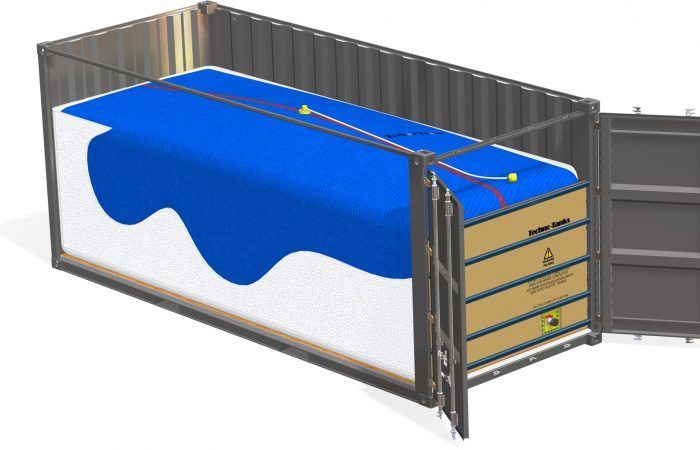
Flexitank Water Storage Bag Sizes And Uses
Read Count : 255
Category : Blogs
Sub Category : Miscellaneous
Flexitanks are flexible containers whose capacity range between 50L and 26 tons depending on the liquids' gravity. The storage containers offer various benefits over other kinds of liquid storage, for instance, steel tanks or rigid plastic. The range of technical fabrics accessible for manufacturing flexibags has led to a wide array of specifications and categories. Some tanks are for impermanent use while others can comprise a liquid for some years at a time or you can reuse them. If you're looking to invest in these containers for liquid transportation, here's what you should know. Sizes Multi-layered These are accessible in sizes ranging from 10,000-24,000 liters. They can carry a huge array of free- flowing non-dangerous liquids, both non-food grade and food grade. These bags comprise seamless PE films to decrease the number of welds. These containers are flexible and easy to install. Single-layered They're available in sizes ranging from 10,000-24,000 liters. The semi-transparent material permits product visibility while loading. The design is appropriate for viscous and hard to discharge products. Trailer Flexitanks Flexitanks change a curtain-sided trailer, reefer, or body into a transport solution for non-dangerous liquids. They're accessible in sizes ranging from 10,000-26,000 liters. They can transport a huge array of non-hazardous liquids, both non-food grade and food grade. They're also available in 30", 40" and 45" containers. Their installation is easy with a distinct surge damping system. Moreover, they have a re-usable harness system. Static Tanks Flexitanks are ideal for temporary water storage and numerous other non-dangerous liquids. They're accessible in sizes up to 50,000 liters plus. They're suitable for emergency use, outdoor festivals, and emergency fire fighting. You can link numerous tanks together to load through one feed/inlet. Another feature is that the placement of additional vents, valves, and drains can occur in the storage tank. Special Design Tanks These tanks change a shipping container into a tailored transport solution for distinct applications. With this type, the specification and size undergo customization to meet the application. They can carry a wide range of non-free-flowing liquids such as suspended solids, pastes, and fruits, both food grade and industrial. Flexitank Uses Fuel Storage A flexitank can store liquid fuel, for instance, oil and gasoline. For this role, they're mostly for storage together with protective berm and lining, providing extra containment safety to the neighboring environment. Civilians and military commonly use them as fuel storage in emergency circumstances. Quick fuel access might be necessary for emergencies, so these storage containers are likely to be operational in field hospitals and natural disasters. Storage of Food-grade Liquids The storage containers permit the efficient and safe storage of food-grade liquid ingredients, for instance, various types of juices, oils, and milk. In these applications, the inner lining of the storage container might have particular coating prerequisites to prevent microbial contamination and sustain tank cleanliness. Moreover, they must comprise the EU/FDA approved materials. Water Storage These storage bags are functional in all kinds of emergency operations and disaster relief around the globe. In the preparedness state, they occupy negligible space and their usage and transportation can take place on the spot. Besides fuel, portable water should be readily accessible particularly in a situation where it might be scarce. For example, the storage of portable water is essential for natural disasters and field hospitals. Since approved tanks can be safe for drinking water, they're the default solution in such scenarios. Temporary Storage and Single-use In some applications, you need temporary storage, making the purchase of a composite or steel tank not worth it. Such situations typically take place in industrial uses or abrupt droughts, where storage needs can oscillate. In such instances, flexitanks for sale can reduce the overall storage expenses. Additionally, the tanks can be used for transporting liquids because you can fill them inside a shipping container for efficient shipping of gels and liquids. The Storage of Industrial Chemicals These tanks are ideal for storing and transporting industrial liquid chemicals, including lubricants and liquid detergents. Procedures for discharging and loading A flexitank's installation can occur at a container yard or the consignee's premises. It takes approximately 30 minutes to install it into a 20-ft container. To load the tank, you connect a hose to the loading connection and pump in the liquid. Based on the kind of cargo, you'll take about ½ hour to fill the tank and after completion, the tank and container are ready for transportation by rail, sea, or road. At the delivery place, the only equipment necessary is a pump for discharging the cargo. Some liquids exhibit certain physical and chemical properties where they become more viscous in lower temperatures or storage. To permit the smooth unloading, the installation of a heating pad takes place in the container and the tank. Hot water or steam works to warm the cargo and pad before the unloading begins, permitting the easy discharge of the cargo. Flexitank Layers Multilayer The major benefit of the multilayer tank is that each layer is flexible and thin, making it easy to complete the unloading. However, they can break since the layers are very thin and product extraction is difficult. Monolayer In this type, one layer of polyethylene is thicker compared to the multilayer and thus, less flexible. This type solves the issue of multilayer tanks (impossibility to extract the remaining product between the layers). In a case where a product isn't flexible, rupture can occur in the bag. Flexitank storage is a comparatively new and effectual means of storing liquids for different applications. If you're looking to transport liquids, this guide offers insight into the container.
Comments
- No Comments

